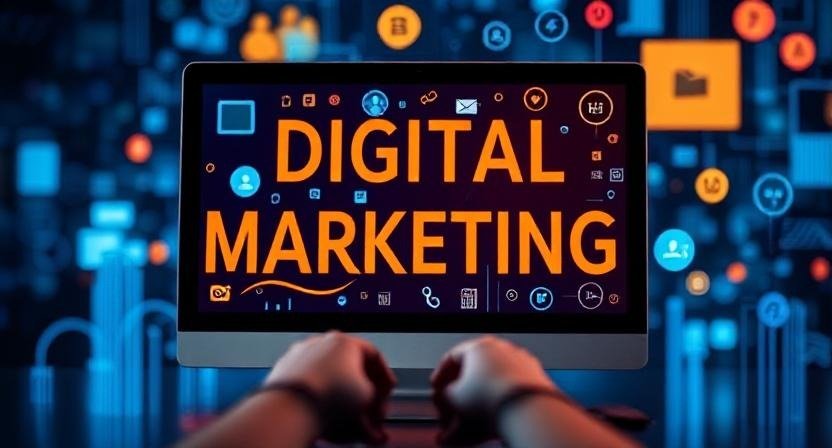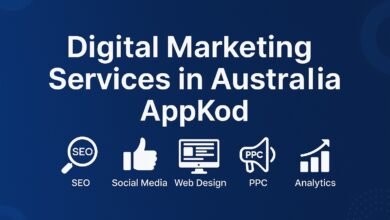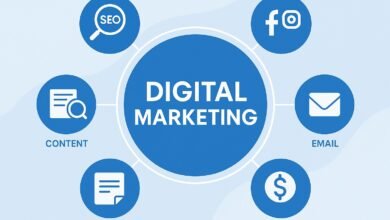Digital Marketing: The Ultimate Guide to Online Business Success

Introduction
In today’s fast-paced digital world, businesses must embrace digital marketing to stay competitive and reach their target audience. Unlike traditional marketing, digital marketing leverages online platforms to promote products and services effectively. Whether you run a small startup or a multinational corporation, understanding and utilizing digital marketing strategies can significantly boost your brand’s visibility, engagement, and sales.
This guide will walk you through the various types of digital marketing, their benefits, and how to create a successful digital marketing strategy.
What is Digital Marketing?
Digital marketing refers to the use of digital channels such as search engines, social media, websites, and email to promote a brand’s products or services. It allows businesses to connect with their audience online, where most consumers spend their time.
Quick Fact
💡 Did you know? Over 4.9 billion people worldwide use the internet, making digital marketing one of the most powerful tools for reaching potential customers.
Types of Digital Marketing
Digital marketing consists of several components, each designed to target different online audiences.
1. Search Engine Optimization (SEO)
SEO is the process of optimizing a website to rank higher in search engine results. This is achieved through:
-
Keyword research – Identifying relevant keywords people search for.
-
On-page optimization – Optimizing website content and structure.
-
Backlink building – Acquiring links from reputable websites to increase credibility.
A strong SEO strategy increases organic traffic and enhances online visibility.
2. Content Marketing
Content marketing focuses on creating and sharing valuable content to attract and engage an audience. Common types of content include:
-
Blog posts – Informative articles that establish authority.
-
Videos – Engaging content that explains products or services.
-
Infographics – Visually appealing data presentations.
-
E-books & Whitepapers – In-depth resources that educate consumers.
Providing high-quality content builds trust with customers and improves brand reputation.
3. Social Media Marketing
Social media platforms like Facebook, Instagram, Twitter, LinkedIn, and TikTok are essential for business growth. They allow brands to:
-
Engage with their audience.
-
Increase brand awareness.
-
Drive traffic to their website.
-
Run targeted ad campaigns.
Social media marketing is one of the most cost-effective ways to connect with consumers and enhance customer loyalty.
4. Pay-Per-Click Advertising (PPC)
PPC is a paid advertising model where businesses pay for each click on their ad. Popular PPC platforms include:
-
Google Ads – Displays ads on Google search results.
-
Facebook Ads – Targets specific demographics.
-
Instagram Ads – Engages users through visually appealing ads.
PPC is an excellent way to generate quick traffic and leads.
5. Email Marketing
Email marketing remains one of the most effective digital marketing strategies. Businesses use it for:
-
Promotional campaigns – Announcing special offers.
-
Newsletters – Keeping customers informed.
-
Personalized recommendations – Engaging users with tailored content.
A well-planned email marketing campaign can boost customer retention and increase conversions.
6. Affiliate Marketing
Affiliate marketing involves partnering with third-party individuals (affiliates) who promote a business’s products in exchange for a commission. It’s an excellent way to:
-
Expand brand reach.
-
Increase sales without upfront advertising costs.
-
Leverage influencer credibility.
7. Influencer Marketing
This strategy involves collaborating with social media influencers to promote a brand. Influencers have dedicated followers who trust their recommendations, making this a powerful tool for brand awareness and credibility.
8. Video Marketing
Videos are one of the most engaging forms of content. Platforms like YouTube, Instagram Reels, and TikTok allow brands to:
-
Demonstrate products.
-
Share testimonials.
-
Educate consumers.
Video content increases user engagement and improves search rankings.
9. Mobile Marketing
With more people using smartphones, mobile marketing has become crucial. It includes:
-
SMS marketing – Sending promotional messages.
-
App-based marketing – Engaging users through mobile apps.
-
Mobile-friendly websites – Ensuring websites are optimized for mobile users.
A mobile-first approach ensures businesses reach consumers on their preferred devices.
Benefits of Digital Marketing
1. Cost-Effective
Unlike traditional marketing, digital marketing offers affordable advertising options, making it accessible for small businesses.
2. Measurable Results
With tools like Google Analytics and Facebook Insights, businesses can track campaign performance in real time.
3. Global Reach
Digital marketing enables businesses to reach audiences beyond their local markets, expanding their customer base.
4. Targeted Advertising
Platforms like Google Ads and Facebook allow businesses to target specific demographics, ensuring ads reach the right people.
5. Improved Engagement
Social media and email marketing enable businesses to interact directly with their audience, fostering strong relationships.
How to Create a Successful Digital Marketing Strategy
To succeed in digital marketing, businesses must develop a well-planned strategy. Here’s how:
1. Define Your Goals
Set clear objectives such as increasing brand awareness, generating leads, or boosting sales.
2. Identify Your Target Audience
Understand who your ideal customers are, their preferences, and online behavior.
3. Choose the Right Channels
Select digital marketing platforms that align with your business goals and audience.
4. Create High-Quality Content
Ensure your content is engaging, informative, and optimized for search engines.
5. Optimize for SEO
Use the right keywords, optimize website speed, and build high-quality backlinks to improve search rankings.
6. Leverage Paid Advertising
Invest in PPC campaigns and social media ads to drive traffic and conversions quickly.
7. Track and Analyze Performance
Regularly monitor your digital marketing efforts and adjust strategies based on data insights.
Future Trends in Digital Marketing
🚀 Voice Search Optimization – More consumers are using voice assistants like Alexa and Siri, making voice search optimization essential.
📱 AI-Powered Marketing – Artificial intelligence helps businesses personalize content and automate customer interactions.
🎥 Short-Form Video Content – TikTok and Instagram Reels continue to dominate, making video content a key marketing tool.
Conclusion
Digital marketing is an essential strategy for businesses looking to succeed in the modern digital landscape. By leveraging SEO, content marketing, social media, PPC, email campaigns, and other online marketing tactics, brands can effectively reach and engage their audience.
💡 Final Thought: In today’s digital-first world, businesses that embrace digital marketing will thrive, while those that ignore it risk falling behind.



